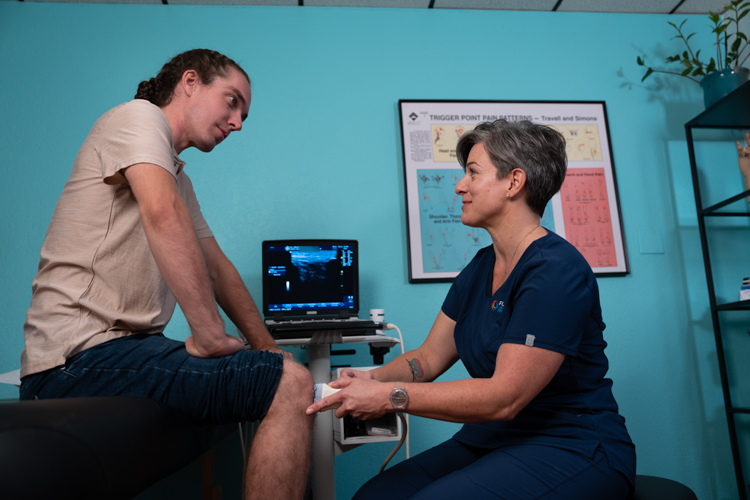Through the years of treating thousands of patients, I have discovered there are definite fears and many “what ifs” wrapped around knee pain. One of the major fears is, “What if I need surgery?”
Knee surgeries range from minimally invasive to more serious such as when a whole joint is replaced. Understandably, it’s a big decision to decide which treatment direction.
Some reasons for this fear include:
- Invasive nature
- Cost
- Length and inconvenience of recovery
- Permanence
- Lack of guaranteed results
Thankfully for most people, knee pain can be effectively fixed or managed with a non-surgical conservative approach. Sometimes it takes a simple treatment solution, and other times it may be slightly more involved using a team approach. Whether it be knee joint pain, knee osteoarthritis or a minor sports injury, surgery should always be a last resort for treating knee pain.
Let’s explore ways to achieve knee pain relief without surgery
First, determine WHEN you should come in for an evaluation of your knee pain.
After having successful knee pain treatments, one of the most common things we hear from patients is, “I wish I would’ve come in sooner.” The sooner we evaluate your knee pain, the better. As in most things in medicine, early detection is critical. Catching an issue before it’s too far gone can provide a profoundly positive outcome.
As a general rule, if the knee is swollen, causing disabling pain, or feeling unstable, you should come in as soon as possible. If there is no swelling and it is a more nagging, limiting pain, it’s still best not to let it go for more than a few weeks. Usually, minor treatment options can ease the pain and get you back on track quickly.
Next, define WHAT is causing your knee pain
There are many causes of knee pain; too many to list here. That’s why it’s of utmost importance to seek a medical provider that takes ample time to listen to your symptoms, examines you thoroughly, and has the experience to discern different pain presentations. Treatment from the right provider can be life-changing.
Many patients’ knee pain is misdiagnosed or given “cookie-cutter” diagnoses and treatment plans. This only perpetuates the knee pain or can even make it worse. You want a provider that sees the whole picture of your health and body mechanics since they all play a role. It should be a holistic approach. A holistic approach leads to more successful results and the prevention of future recurring knee pain.
Finally, discover HOW to fix or manage the knee pain

A comprehensive approach is the most effective way to relieve pain now and to keeping pain from coming back or worsening in the future. All in all, our bodies have the potential to heal; it’s a matter of figuring out the “right concoction” for long term relief.
In addition to lifestyle changes and other conservative treatments such as physical rehabilitation, there are some great injection options that are safe, non-invasive, effective, and require little to no recovery time.
1. Steroid and Toradol Injections
Steroid injections are used as a standard treatment for knee pain relief, as they can help reduce inflammation, decrease pain, and improve function. It’s essential to remember that steroids are not always a “bandaid.” If used correctly, anti-inflammatory medications like steroids can fix the problem. Nonetheless, this medication should be taken seriously and used conservatively to avoid harm.
Another option that is NOT a steroid is Toradol. Toradol is a non-steroidal anti-inflammatory drug (NSAID) that can also be injected into the knee to help with inflammation, pain, and function. Certain pain conditions respond well to this option and other conditions that do not. Also, some patients are not a candidate for this medication.
2. Viscosupplementation (“Gel shots”)
With “wear and tear” or injury, patients can lose cartilage and its cushioning in their joints. This loss of cushioning can cause further damage to the parts of the knee and lead to all kinds of other problems. The steroid mentioned above and Toradol injections do not provide cushion or protection of the joint. In some of these cases, gel shots may be a better option.
Gel shots or hyaluronic acid injections are a treatment that can help provide a cushion in the joint by enhancing the viscosity of the synovial fluid. While this treatment does not repair your cartilage or rebuild it, it can help protect it from further damage. It also provides pain relief and significantly improved function.
3. Platelet Rich Plasma (PRP) Therapy
If a patient and their provider decide that steroids and Toradol are not good options, an excellent alternative to discuss is PRP. It’s a treatment that uses your own body’s healing properties to help with pain and inflammation.
PRP works by using your own blood plasma to stimulate healing in the affected area. Platelets contain healing properties aimed at reducing pain and inflammation and potentially helping repair the tendon or joint.
The key to PRP treatment is the quality of the PRP kit and the provider’s expertise. Not all PRP kits are created equally. This is a big issue in the pain and orthopedic industry. You want to seek a provider who uses premium PRP kits with effective platelet concentrating ability. You also want an experienced provider who uses ultrasound guidance to inject the PRP effectively.
4. Allografts such as Amniotic and Cord Blood Therapy
If a patient is not a candidate for PRP, they might be a candidate for an “allograft” injection. PRP is your own body product, so we call that “autograft.” In contrast, it is called ” allograft ” when it is someone else’s body product. Many people refer to it as “stem cell” treatment, but that is a misnomer. There are no stem cells in most of these products anywhere!! There is a lot of mis-marketing out there. They do have mesenchymal signaling cells and many other healing properties that play an essential role in pain, inflammation, and repair.
Nonetheless, this option provides excellent healing properties like PRP but is much more potent. There are many options nowadays in the realm of an allograft. Seek a provider that has time to sit down and discuss these options so that you fully understand and feel comfortable moving forward.



